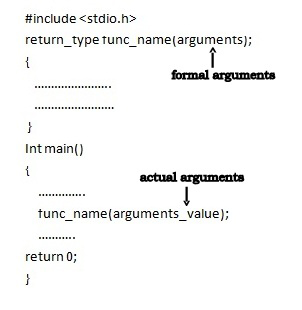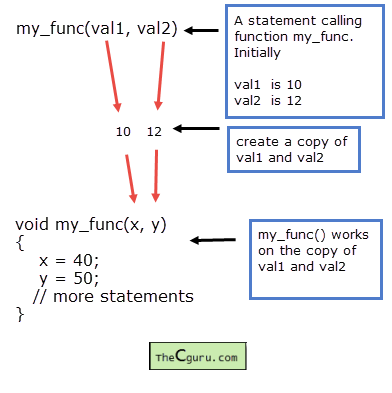argc (ARGument Count) is int and stores number of command-line arguments passed by the user including the name of the program. The value of argc should be non negative.argv (ARGument Vector) is array of character pointers listing all the arguments.More items Microsoft Specific. The following function that takes a string of characters with name as parameter. Let's see an example of how it is done. Sum of a = 10 and b = 20 is = 30. This copy is destroyed when the function terminates. In this chapter, you will learn about the use of command-line argument in C. The main () function is the most significant function of C and C++ languages. Secondly, we can pass the entire structure to the function (call by value). Here is the simple program for printing functions with arguments and without arguments examples in C++. The following simple example program will have three calls to our variadic function addingNumbers. {. C function with arguments (parameters) and with return value. C++ has many features, and one of the most important features is function overloading. Function will add the two numbers so it should have some meaningful name like sum, addition, etc.  For an introduction on generic C Macros, this might help: How to Use C Macros and C Inline Functions with C Code Examples.
For an introduction on generic C Macros, this might help: How to Use C Macros and C Inline Functions with C Code Examples. Many plotting functions have an input argument called linespec for customizing. In the stack.c example, note that the call on push() has two arguments in C and one in C++. In the end, the return statement is also mandatory depending upon what output we want according to the function definition.
 Above example demonstrate the use of object as a parameter.
Above example demonstrate the use of object as a parameter.
The command line parsing rules used by Microsoft C/C++ code are Microsoft-specific. va_list a_list; va_start( a_list, x ); } va_arg takes a va_list and a variable type, and returns the next argument in the list in the form of whatever variable type it is told. Enter values to be added 5 9 The sum is 14. This can be done in exactly the same way as we pass variables to a function. constant argument to a function.
The default arguments are used during compilation of program. When the function is called, we pass along a name, which is used inside the function to print "Hello" and the name of While this apparently defines an infinite You must end the declaration of the function's arguments or parameters using the three periods or dots to tell the compiler that an unknown number of arguments will be passed to that function. result = square (a); // square function is called. The example demonstrates an original use case of the UART and C-Function Call blocks used to process character strings which are not natively handled by Simulink. Kourosh23. The execl() function uses a sentinel (null pointer) to mark the end of the argument list. In the below program, function square is called from main function. The family of functions is an example of functions that use variable argument lists.printfargument-declaration-list. For example, printf () scans the formatting string to know how many parameters to expect while execl () requires you to pass NULL as last argument. Then, the return statement can be used to return a value from a function. Formal parameters are those parameters that are present in the function definition. Said differently, when you create a function, you can pass in data in the form of an argument, also called a parameter. Let us understand default arguments in C++ with an example. A function may or may-not contain parameter list. Create a user-defined function named sayHello (). Working of default arguments How default arguments work in C++. For example: This example prints 2 to standard output, because the a referred to in the declaration of g () is the one at file scope, which has the value 2 when g () is called. float (*a) (int, int); // declaration of a pointer to a function. Recursion (adjective: recursive) occurs when a thing is defined in terms of itself or of its type.Recursion is used in a variety of disciplines ranging from linguistics to logic.The most common application of recursion is in mathematics and computer science, where a function being defined is applied within its own definition. In the above case, we have declared a function named as ' add '. constant argument to a function . For example: func1(12, 23); here 12 and 23 are actual arguments. Call by reference - sending the address of the arguments. a=add; // assigning address of add () to 'a' pointer. Enclose arguments of functions in parentheses and include a multiplication sign between terms. Step 6 Create HTML Markup. ; When temp(6) is called, the first argument becomes 6 while the default value is used for the second parameter. Default arguments in C++ functions (C++ only) You can provide default values for function parameters. The C standard library provides numerous built-in functions that your program can call. Argument definition. The following is a simple example of a function:. Output. Single Argument : When the above code is compiled and executed with a single argument separated by space but inside double quotes, it produces the following output. Lambda calculus (also written as -calculus) is a formal system in mathematical logic for expressing computation based on function abstraction and application using variable binding and substitution.It is a universal model of computation that can be used to simulate any Turing machine.It was introduced by the mathematician Alonzo Church in the 1930s as part of his Calling the function - We have called the square method by passing the value of an int variable named a as an argument. This function addition adds two integer variables, which means I need two integer variable as input, lets provide two integer parameters in the function signature. return x + y + z; } Here both the function names are add but the first function is taking 2 integers and the second function is taking 3 integers. The function can then use that information as it runs, like a variable. ; define a greet2() macro for when the greet() macro is called with two arguments. This means that the function returns an int value. The most common example is printf(). Argument with return value. These command line arguments are always handled by the main () functions. The arguments that are generally passed from the line of command are referred to as command line arguments. Print some text on the console when the sayHello () function is called. What we did is: name the function somewhat different (greetX()) and write it as we would normally do, with no notion of being variadic.define greet() as a variadic macro (rather than a function); define a greet1() macro for when the greet() macro is called with only one argument. We are passing d1 and d2 objects as arguments to the sum member function and adding the value of data members a of both objects and assigning to the current objects (that will call the function, which is d3) data member a. $ ./a.out "First Second Third" Program Name Is: ./a.out Number Of Arguments Passed: 2 ----Following Are The Command Line Arguments Passed---- argv[0]: ./a.out argv[1]: First Second Third To understand the working of function overriding in C++, consider a simple example: In the above example, it defines the print () function in both the base class, that is, parent_class as well as the derived class i.e., derived_class with the same function signature but a different function definition. These functions may or may not return values to the calling function. This can be useful sometimes but not in general and lead to hard to find bugs. Algebra questions and answers. Include the std namespace in our code to use its classes without calling it. We have also declared the function pointer (*a) which returns the floating-type value, and contains two parameters of integer type. A pointer to a function is declared as follows, type (*pointer-name) (parameter); Here is an example : int (*sum) (); //legal declaration of pointer to function int *sum (); //This is not a declaration of pointer to function. As you have seen earlier we need 3 statements in order to make a function and execute it. Under function name, we can pass as many arguments we want depending on the requirement of the code. The objects of a class can be passed as arguments to member functions as well as nonmember functions either by value or by reference.
It then moves down the list to the next argument. \ [ \log (11 a \cdot 17 \] Question: Enclose arguments of functions in parentheses and include a multiplication sign between terms. The first way is to pass the structure members to the function. cout<<"\n\n Changed value of object1 "<
void pass (Sample obj1, Sample obj2) //objects are passed. C++ Program of Friend functions having objects as arguments. The runtime startup code uses these rules when interpreting arguments given on the operating system command line: Arguments are delimited by white space, which is either a space or a tab. Secondly, we can pass the entire structure to the function (call by value). // code to be executed. } Parameters are variables to hold values of arguments passed while function is called. Function arguments in c programming Pass by Value. Note that In C programming, it is also possible to pass the address of a variable to the function instead of the variable value.
The int variable a has a value 5 and it can also be referred as "actual argument" of the square method, when it is called. Call by value. It would be possible to use a count Video lectures on Youtube. C makes it possible to pass values from the command line at execution time in your program. Function with argument example In the upcoming example, we are going to create a function named square which calculates the square of each variable of int type passed to it, when this function is called. The number of arguments passed to the program is represented by argc and every argument passed to the program is pointed by a pointer which is maintained in a pointer array represented by argv[]. // function to add two integers int add(int x, int y) //function definition { int z; z=x+y; return z; } Void main() { int a,b,sum; cout<<"Enter values to be added"; cin>>a>>b; sum=add(a,b); //function call cout<<" \n The sum is" <